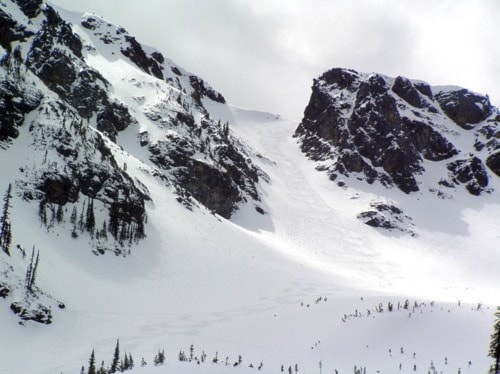OOOoooh the excitement, we are approaching that time of year when the winter snowpack begins to metamorphose into a stable and fast traveling surface. The ski mountaineering season is quickly approaching and it’s time for folks to start thinking about alpine starts, sunscreen, glacier glasses and ski crampons.
With the sun higher in the sky and very warm daytime temperatures powder hounds are retreating to shady north aspects and seeking out those last few face shots. While the sun worshipers and ski mountaineers know this is the time to begin planning for those summits and steep corn snow descents on their “to do” list. While the early and mid-winter snow packs are generally less cohesive, dry and powdery, spring brings the cycle of thawing and freezing conditions. This melt freeze cycle produces a good solid snowpack that tends to be very stable early in the day. With a pre-dawn start ski mountaineers choose steeper terrain and summit climbs with good ski descents such as narrow chutes and couloirs. Most of this terrain is only safe enough once the snowpack has set up like this.
Being in this type of terrain with a frozen snowpack still has hazards that must be addressed. Cornices are massive this year and we have not experienced a major warming cycle quite yet … these giant bus sized chunks of snow can mow you over and leave you looking like the road runner on a bad day. These crazy snow features can also drop onto a common trigger point and cause a deep and large avalanche. So it is imperative to still take the time to do some snowpack analysis and choose your route carefully. You may also use timing to your advantage and do the route after the cornices have already dropped.
Spring ski mountaineering requires some specialized equipment to manage hard snow conditions, exposure and falls. An ice axe can be helpful to self-belay for a particularly steep ascent that requires “boot packing” or hiking with your skis on your pack. Often the terrain is just too steep to set a skin track. Ski crampons are pretty much essential for traveling on frozen snow before the sun softens it up. Glacier travel skills and crevasse rescue training is also mandatory for anyone going into the big alpine glaciated terrain.
We provide excellent and fun courses in glacier travel and crevasse rescue with upcoming dates in during April, May and June, near Blue River, B.C. These courses are situated in stunning alpine locations and our base camps include a large heated cooking and leisure tent. Need some sun and fun on snow? Come join us … we supply all camping and technical equipment.
– This column is sponsored by Snowy Mountain Alpine Tours
